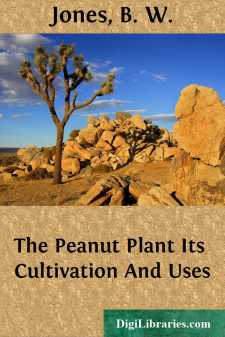Categories
- Antiques & Collectibles 13
- Architecture 36
- Art 48
- Bibles 22
- Biography & Autobiography 813
- Body, Mind & Spirit 142
- Business & Economics 28
- Children's Books 17
- Children's Fiction 14
- Computers 4
- Cooking 94
- Crafts & Hobbies 4
- Drama 346
- Education 46
- Family & Relationships 57
- Fiction 11829
- Games 19
- Gardening 17
- Health & Fitness 34
- History 1377
- House & Home 1
- Humor 147
- Juvenile Fiction 1873
- Juvenile Nonfiction 202
- Language Arts & Disciplines 88
- Law 16
- Literary Collections 686
- Literary Criticism 179
- Mathematics 13
- Medical 41
- Music 40
- Nature 179
- Non-Classifiable 1768
- Performing Arts 7
- Periodicals 1453
- Philosophy 64
- Photography 2
- Poetry 896
- Political Science 203
- Psychology 42
- Reference 154
- Religion 513
- Science 126
- Self-Help 84
- Social Science 81
- Sports & Recreation 34
- Study Aids 3
- Technology & Engineering 59
- Transportation 23
- Travel 463
- True Crime 29
The Peanut Plant Its Cultivation And Uses
by: B. W. Jones
Categories:
Description:
Excerpt
CHAPTER I.
Origin.—The native country of the Peanut (Arachis hypogæa) is not definitely ascertained. Like many other extensively cultivated plants, it has not been found in a truly wild state. Some botanists regard the plant as a native of Africa, and brought to the New World soon after its discovery. Sloane, in his history of Jamaica, states that peanuts formed a part of the provisions taken by the slave ships for the support of the negroes on the voyage, and leaves it to be inferred that the plant was introduced in this manner. De Candolle, in Géographie Botanique Raisonnée, and his latter work on L'Origine des Plantes Cultivées, strongly inclines to the American origin of the Peanut. The absence of any mention of the plant by early Egyptian and Arabic writers, and the fact that there is no name for it in Sanscrit and Bengalese, are regarded as telling against its Oriental origin. Moreover, there are six other species of Arachis, natives of Brazil, and Bentham and Hooker, in their Genera Plantarum, ask if the plant so generally grown in warm countries may not be a cultivated form of a Brazilian species.
If, as seems probable, the Peanut is really a native of America, then this Continent has contributed to the agricultural world five plants that have exerted, and will continue to exert, an immense influence on the industries and commerce of the world. These are: the Potato, Cotton, Tobacco, Indian Corn, and the Peanut. Of these five, the Peanut, the last to come into general and prominent notice, is destined to rival some of the others in importance.
Whatever may have been its origin, the Peanut plant has gradually made its way over an extended area of the warmer parts of both the Old and New World, and in North America has gained a permanent foot-hold in the soil of the South Atlantic and Gulf States. Nor has it yet reached its ultimate limits, for cultivation and acclimation will inure it to a sterner climate, until it becomes an important crop in latitudes considerably further north than Virginia. This is indicated by its rapid spread within the past few years. Remaining long in comparative obscurity, it was not until a recent period that the Peanut gained prominence as an agricultural and commercial staple, but since it fairly started, its progress has been rapid and sure.
Natural History.—There are some peculiarities about the Peanut plant that make it interesting to the naturalist. Its habit of clinging close to the soil, the closing together of the leaves at sunset, or on the approach of a storm, the beautiful appearance of a field of it when full grown, and the remarkable wart-like excrescences found upon the roots, are some of its more notable characteristics. Its striking preference for a calcareous soil is another of its peculiarities, the Peanut producing more and better crops on this kind of soil than on any other.
The Peanut belongs to the Natural Order Leguminosæ, or pod-bearing plants, and this particular member of it is as unlike all the rest with which we are acquainted, as can well be conceived....


